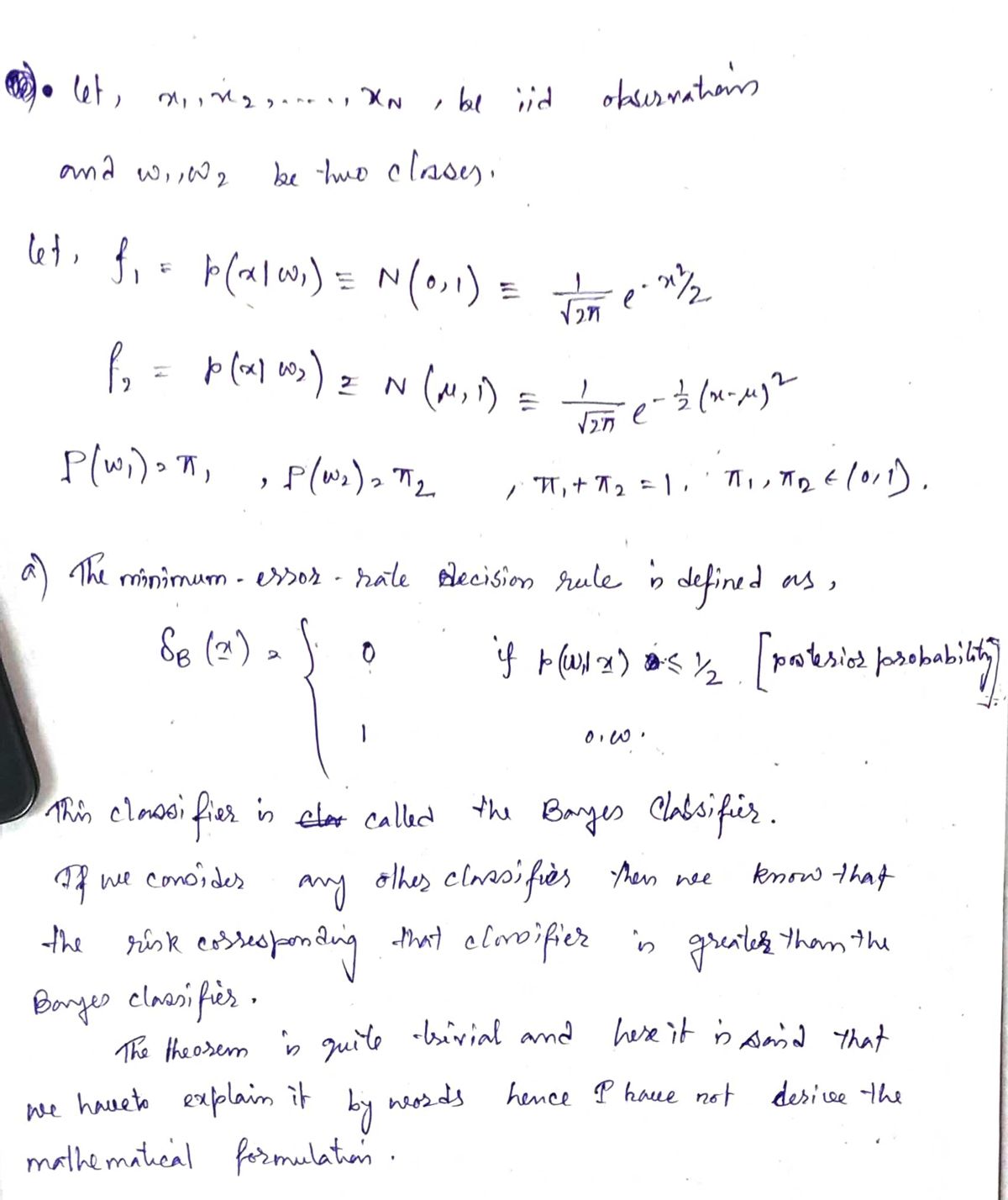Suppose we are to make a two-class classification decision based on observations of a scalar random variable x. Suppose we collect N such observations, x₁, i=1,K,N and suppose they are independent and identically distributed (i.i.d.). Let us further suppose the following PDFs for a single observation of x under two states of nature (classes) @ and @2₂: p(x|@)= 1 -x²/2 2π p(x| @₂) = -√2e²(x-µ)²/2 a) Write the general expression given in class for the minimum-error-rate decision rule Explain briefly in words how we derived this rule. b) Beginning from the definition you stated in part (a), derive the minimum-error-rate decision rule for N i.i.d. observations of x, given the PDFs specified above. Assume that μ = 2 and P(@₂)=eP(@) (e = 2.71828....). Hints: Use the natural logarithm (ln) to simplify your answer. Your final answer should be of the form g(x) >T, where x=(x₁,K,x) and T is a threshold. c) Now write your answer to part (b) for the case when only one observation is obtained (i.e., N=1). Your decision rule should again be of the form g(x) >T.
Suppose we are to make a two-class classification decision based on observations of a scalar random variable x. Suppose we collect N such observations, x₁, i=1,K,N and suppose they are independent and identically distributed (i.i.d.). Let us further suppose the following PDFs for a single observation of x under two states of nature (classes) @ and @2₂: p(x|@)= 1 -x²/2 2π p(x| @₂) = -√2e²(x-µ)²/2 a) Write the general expression given in class for the minimum-error-rate decision rule Explain briefly in words how we derived this rule. b) Beginning from the definition you stated in part (a), derive the minimum-error-rate decision rule for N i.i.d. observations of x, given the PDFs specified above. Assume that μ = 2 and P(@₂)=eP(@) (e = 2.71828....). Hints: Use the natural logarithm (ln) to simplify your answer. Your final answer should be of the form g(x) >T, where x=(x₁,K,x) and T is a threshold. c) Now write your answer to part (b) for the case when only one observation is obtained (i.e., N=1). Your decision rule should again be of the form g(x) >T.
A First Course in Probability (10th Edition)
10th Edition
ISBN:9780134753119
Author:Sheldon Ross
Publisher:Sheldon Ross
Chapter1: Combinatorial Analysis
Section: Chapter Questions
Problem 1.1P: a. How many different 7-place license plates are possible if the first 2 places are for letters and...
Related questions
Question
Show all work please!
Bayes Decision Theory

Transcribed Image Text:Suppose we are to make a two-class classification decision based on observations of a scalar
random variable x. Suppose we collect N such observations, x;, i=1,K,N and suppose
they are independent and identically distributed (i.i.d.). Let us further suppose the following
PDFs for a single observation of x under two states of nature (classes) @ and @₂:
=e=x²12
p(x|w) = -
1
2π
1
p(x|@₂) = - =e-(x-μ)²³/2_
√√2π
a) Write the general expression given in class for the minimum-error-rate decision rule.
Explain briefly in words how we derived this rule.
b) Beginning from the definition you stated in part (a), derive the minimum-error-rate
decision rule for N i.i.d. observations of x, given the PDFs specified above. Assume that
μ = 2 and P(@₂)=eP(w) (e = 2.71828....). Hints: Use the natural logarithm (ln) to
simplify your answer. Your final answer should be of the form g(x) >T, where
x = (x₁,K,x) and T is a threshold.
c) Now write your answer to part (b) for the case when only one observation is obtained
(i.e., N=1). Your decision rule should again be of the form g(x) >T.
d) Roughly sketch the PDFs p(x|@) and p(x|@₂), and indicate the threshold T (from part
(c)) on the graph. Explain in words why this value of T' is logical.
e) In general, when a parameter of the PDFs is unknown (such as in this problem), how
can you specify the decision rule? (Answer briefly. Don't work out the specific solution
for this problem).
Expert Solution
Step 1

Step by step
Solved in 4 steps with 4 images

Recommended textbooks for you

A First Course in Probability (10th Edition)
Probability
ISBN:
9780134753119
Author:
Sheldon Ross
Publisher:
PEARSON


A First Course in Probability (10th Edition)
Probability
ISBN:
9780134753119
Author:
Sheldon Ross
Publisher:
PEARSON
